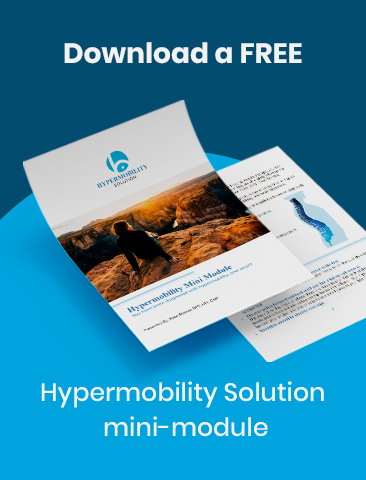For those living with hypermobility, achieving deep, restorative sleep can often feel elusive. While sleep is essential for everyone, it becomes even more critical when managing pain, balancing anxiety levels, and optimizing the body's healing process.
So, if mornings often greet you with exhaustion or discomfort, it might be time to reassess your sleeping habits. Let's dive deep into the world of sleeping with hypermobility.

Sleeping Positions That Complement Hypermobility
Before splurging on a top-of-the-line mattress, it's essential to evaluate your sleeping position. Finding one that offers adequate support for the SI joint and lower back is particularly crucial. Although stomach sleeping might be your go-to, it could be compromising this support. Side sleeping often emerges as a better option, ensuring proper alignment and better rest.

Crafting Your Ideal Sleep Environment
A serene sleeping environment transcends the mere aesthetics of your bedroom. It's a careful interplay of the mattress, pillows, and other sleep aides you employ.
For the hypermobile sleeper, a firm mattress generally does wonders. It supports your relaxed muscles during sleep and helps avoid any distorted, pain-inducing positions come morning.
But remember, the priciest mattress isn't necessarily the best fit for you. Instead, hone in on what suits your unique needs. And if those needs evolve, ensure your mattress can adapt to them.

Pillow Talk: Making the Right Choice
Pillows can make or break your sleep quality. When you're settling down on your side, two firm pillows can fill the gap between your head and mattress, offering the support your shoulder and hip crave.
If you're prone to rolling or struggle with lower back discomfort, strategically placed pillows can be your saving grace. Opt for medium-firm fiberfill pillows; they're more reliable than the memory foam or down variants that can shift as the night wears on.

Leveraging Your Mattress Warranty
A mattress is an investment, both in money and in your well-being. Don't shy away from using its warranty to its fullest. Sometimes, a mattress that feels heavenly in the store doesn't translate the same in your home. If that's the case, consider it a lesson learned and exchange it for another more suited to your needs.

We have covered the basics of sleeping with Hypermobility. Try these tips out, and I assure you will see a difference in your rest and your life in general.
Sweet dreams!
Looking for an online support team? Join the Hypermobility Solution Facebook Group here!
Related blog posts:

About Kate

Kate Skinner is a Doctor in Physical Therapy, co-founder of Great Divide Physical Therapy, and creator of Hypermobility Solution.
Recent Posts

2 thoughts on “Sleeping with Hypermobility: A Comprehensive Guide”
Leave a Comment
You must be logged in to post a comment.


There was NO advice in this article!!! 0/10
Thank you for your feedback. I appreciate you taking the time to read the article and share your thoughts. This article aimed to provide an understanding of the foundational aspects of sleep and its relationship with hypermobility, including the importance of sleep, identifying sleep problems, and basic steps towards improving sleep like considering your sleeping position and setup.
However, I understand that you might have been looking for more specific advice. Here is some specific advice for better sleep if you are dealing with hypermobility:
– Start by adjusting your sleeping position before considering a change in pillows and mattresses. A proper sleeping position is crucial for good health and pain management.
– Hypermobility requires support for the SI joint and lower back. Sleeping on your stomach can compromise this support, so it is generally better to avoid it.
– Using two firm pillows can be helpful to fill the gap between your head and the mattress, providing support to your shoulder and hip while sleeping on your side.
– If you tend to roll forward in your sleep, adding a pillow in front can prevent this. Similarly, if you have lower back or SI joint issues, placing a pillow between your knees can provide relief.
– Remember to move as a unit while changing positions to avoid pain. Log rolling (moving your body all at once as opposed to twisting or bending parts of it separately) is often the best method to use when turning over in bed.
– Adjustable neck support, properly placed, can reduce discomfort and promote better sleep.
Consider using medium firm fiberfill pillows for better sleep. Memory foam and down pillows tend to shift and move during the night.
In the future, we plan on delving deeper into these topics with actionable tips and strategies. We also encourage those seeking more immediate advice to consider joining the Hypermobility Solution Facebook Group for support and discussions on this topic. Again, thank you for your feedback as it helps us improve and better serve our readers’ needs.
Kate Skinner.